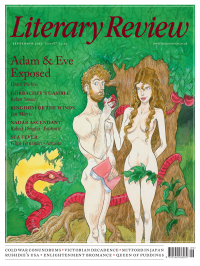Tom Williams
Whose Line Is It Anyway?
Reconciliation
By Guy Ware
Salt Publishing 300pp £8.99
Reconciliation opens with an intriguing apology by the author ‘for the extent to which my characters fail to resemble their real-life models’. This indicates a central concern of Guy Ware’s novel: namely, how the fiction writer appropriates ‘facts’ to create a story. It’s a preoccupation that informs the book’s highly original narrative structure.
The first part of Reconciliation gives a taste of the sorts of slippages in time and mode with which the reader must contend. The book opens in February 2003, when Martin, the narrator, is in a testy relationship with Holly, an archivist working in Cambridge. The tensions between them worsen

Sign Up to our newsletter
Receive free articles, highlights from the archive, news, details of prizes, and much more.@Lit_Review
Follow Literary Review on Twitter
Twitter Feed
Alfred, Lord Tennyson is practically a byword for old-fashioned Victorian grandeur, rarely pictured without a cravat and a serious beard.
Seamus Perry tries to picture him as a younger man.
Seamus Perry - Before the Beard
Seamus Perry: Before the Beard - The Boundless Deep: Young Tennyson, Science, and the Crisis of Belief by Richard Holmes
literaryreview.co.uk
Novelist Muriel Spark had a tongue that could produce both sugar and poison. It’s no surprise, then, that her letters make for a brilliant read.
@claire_harman considers some of the most entertaining.
Claire Harman - Fighting Words
Claire Harman: Fighting Words - The Letters of Muriel Spark, Volume 1: 1944-1963 by Dan Gunn
literaryreview.co.uk
Of all the articles I’ve published in recent years, this is *by far* my favourite.
✍️ On childhood, memory, and the sea - for @Lit_Review :
https://literaryreview.co.uk/flotsam-and-jetsam